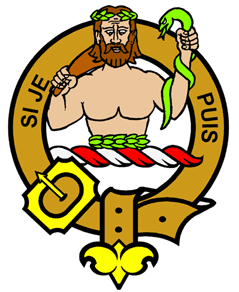Livingstone Clan
Livingstone Clan Crest: A demi savage, wreathed on the head and body, holding a club on the dexter shoulder and a serpent in the sinister hand.
Livingstone Clan Motto: Si Je Puis (If I can).
Livingston(e) Clan History
Legend has it that a Saxon of the name of Leving acquired lands in West Lothian in the 12th century under David I and representatives of the name Leving appear in documents of that period. Sir Archibald de Levingestoune
rendered homage to Edward I of England in 1296.
Sir Archibald's son James was taken prisoner alongside David II at the Battle of Durham in 1346, but was later released. As a Commissioner for the King's release from English captivity, he was given the Barony of Callendar, and in the following centuries the Livingston Family held the earldoms of Callendar, Linlithgow and Newburgh.
Sir Alexander Livingston of Callendar was appointed a guardian of James II and his son, Sir James, became Captain of Stirling Castle and Lord Chamberlain of Scotland under the title of Lord Livingston. Alexander, 5th Lord Livingstone accompanied Mary Queen of Scots to France, where he died. In 1599, Alexander, 7th Lord Livingston, was created Earl of Linlithgow.
James Livingston, younger son of Alexander, 1st Earl of Linlithgow, was created Earl of Callendar by Charles I. The titles later merged, but following the Livingston's support of the Jacobite Cause during the 1715 Uprising, the titles were forfeit.
The small Highland Clan of Livingston originally bore a Gaelic name spelt in different ways – MacDunsleibh, Mac-an-Leigh or MacLea. The amalgamation came about when Sir William Livingston of Skirling, Keeper of the Privy Seal for Charles I, was given a 57-year lease on Achanduin Castle, on the island of Lismore, locally known as the 'Bishop's Castle.' The clansfolk of Lismore had hitherto tried to avoid becoming involved with the surrounding clans – the Stewarts of Appin, the Macleans and the Macdougalls - so rallied around Livingston of Skirling.
The Chief's Charter for lands dates from 1544 and confirms him as the Hereditary Keeper of the Pastoral Staff of St Moluag, an Irish missionary born around 520. On his death, the staff was entrusted to the family who had become almoners to Lismore Cathedral and subsequently Barons of Bachuil. In 1950, a Lyon Court judgement declared that the Custodian of the Staff is the Co-Arb of Saint Moluag and a Baron in the Baronage of Argyll and the Isles.
David Livingstone (1813-73) was born in Blantyre and joined the London Missionary Society. He carried out explorations from Cape of Good Hope to Zambesi, then northwards into Central Africa. Charles Livingstone (1821-73), brother of David Livingstone, joined his brother on African expedition (1821-63) and emigrated to America.
Surname distribution in Scotland: The highest concentrations of the Livingstone name occur in Renfrewshire, Argyll and Bute, Ayrshire, Glasgow, Fife, Edinburgh City, the Lothians (Linlithgowshire, Edinburghshire and Haddingtonshire) and Highland (incorporates the historic counties of Caithness, Inverness-shire, Nairnshire, Ross and Cromarty, Sutherland and small areas of Argyllshire and Morayshire).
Places of Interest:
Callendar, Falkirk, West Lothian. Lands held by Livingstons from the 14th century. A 15th century tower house remains part of the mansion house of a later date and gave its name to the Livingston earldom, although
it is spelled differently.
Livingston, West Lothian. Almshouses were founded here by Henry Livingston in 1496. This is now the site of Livingston New Town.
Achandon, Isle of Lismore. 13th century Livingston stronghold. Now a ruin.
Bachuil, Isle of Lismore. Home of the Livingstons of Bachuil. St Moluag's Staff (also known as the Bachuill Buidhe), which ranks among the oldest ecclesiastical relics on record, is held here.
Blantyre, Lanarkshire. David Livingstone (1813-73), the great explorer, was born here. There is a National Memorial open the year round.
Clan Livingstone membership gift certificate.

